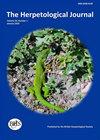Will there be a second extinction? Molecular identification of multiple alien water frogs (Pelophylax ridibundus sensu lato) in Tuscany, Central Italy, reveals genetic pollution within a unique hybridogenetic system
IF 1.1
4区 生物学
Q3 ZOOLOGY
引用次数: 3
Abstract
The introduction of alien water frogs is perhaps one of the most underestimated herpetological conservation issues in Europe. The identification of distinct species is highly challenging at the phenotypic level, and artificial syntopy between various taxa and lineages may lead to diverse outcomes, including hybridisation and local extinction. In central Italy the native synklepton of Pelophylax bergeri (the parental taxon) and P. kl. (klepton) hispanicus (the hybridogenetic hybrid, which clonally transmits the genome of an extinct ridibundus-like taxon) is present. Until recently, data regarding the presence of alien water frogs in central Italy was scarce, and no alien taxa have been reported for Tuscany. In this study, four distinct non-native Pelophylax lineages have been identified via molecular analysis in the Cecina and Arno river basins and ascribed to the Marsh frog group (P. ridibundus sensu lato). Alien Pelophylax ridibundus, P. kurtmuelleri, and P. cf. bedriagae sensu stricto currently appear to be widespread in the Cecina basin. Furthermore, evidence of hybridisation with autochthonous taxa has been suggested by genetic analyses in four out of eight sampling localities. With a view to evaluate urgent conservation strategies, a greater sampling effort is required to assess the actual distribution and ecology of the alien lineages, and further research is necessary to measure their impact on the native hybridogenetic system of the central-southern Italian pool frogs.会有第二次灭绝吗?意大利中部托斯卡纳多只外来水蛙的分子鉴定揭示了一个独特的杂交遗传系统中的遗传污染
外来水蛙的引入可能是欧洲最被低估的爬行动物保护问题之一。不同物种的鉴定在表型水平上极具挑战性,各种分类群和谱系之间的人工合成可能会导致不同的结果,包括杂交和局部灭绝。在意大利中部,存在Pelophylax bergeri(亲本分类单元)和P.kl.(klepton)hispanicus(杂交种杂交种,克隆传递已灭绝的类ridibandus分类单元的基因组)的本地synkleton。直到最近,关于意大利中部存在外来水蛙的数据还很少,托斯卡纳也没有外来分类群的报告。在这项研究中,通过分子分析,在Cecina河和Arno河流域确定了四个不同的非本地Pelophilax谱系,并将其归属于沼泽蛙群(P.ridibundus sensu lato)。目前,在Cecina盆地广泛分布着外来的ridibundus Pelophilax、P.kurtmuelleri和P.cf.Bediagae senso stricto。此外,八个采样点中有四个采样点的遗传分析表明,存在与本地分类群杂交的证据。为了评估紧急的保护策略,需要加大采样力度来评估外来谱系的实际分布和生态,有必要进行进一步的研究,以衡量它们对意大利中南部池蛙本地杂交遗传系统的影响。
本文章由计算机程序翻译,如有差异,请以英文原文为准。
求助全文
约1分钟内获得全文
求助全文
来源期刊

Herpetological Journal
生物-动物学
CiteScore
2.40
自引率
10.00%
发文量
25
审稿时长
>12 weeks
期刊介绍:
The Herpetological Journal is the Society''s prestigious quarterly scientific journal.
 求助内容:
求助内容: 应助结果提醒方式:
应助结果提醒方式:


